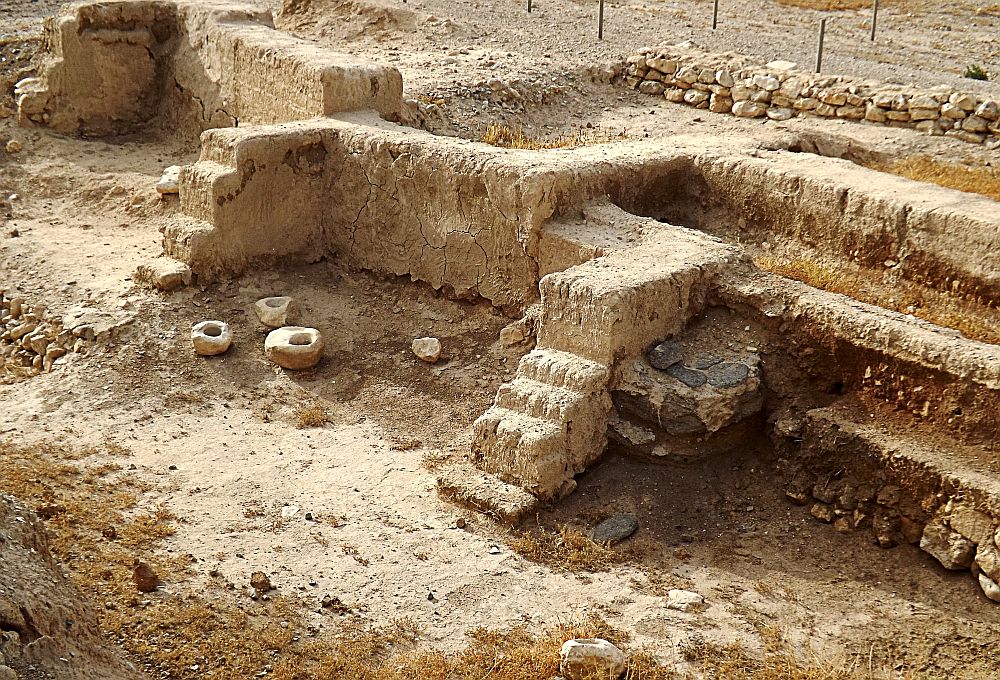
[Image above] Drill core of concrete from a 2,000-year-old Roman breakwater consists of pumice (yellowish inclusions), lava and other volcanic crystalline materials (dark and gray spots), and lime (white). Inset: scanning electron micrograph of aluminum tobermorite crystals believed to provide the superior durability and mechanical properties of Roman seawater concrete. Credit: Lawrence Berkeley National Laboratory.
Scientists working to make modern concrete more durable and sustainable are focusing their attention on ancient technology.
Specifically, a research team led by Paulo Monteiro of the US Department of Energy’s Lawrence Berkeley National Laboratory and the University of California, Berkeley, has analyzed samples from a 2,000-year-old Roman concrete breakwater to determine why Roman seawater concrete is so durable, how its manufacture was more environmentally sound, and how to adapt those characteristics to modern concrete production.
“It’s not that modern concrete isn’t good. It’s so good we use 19 billion tons of it a year,” Monteiro said in a news release. “The problem is that manufacturing Portland cement accounts for seven percent of the carbon dioxide that industry puts into the air.”
Portland cement acts as the primary binding agent in modern concrete, but its production is an energy-intensive process. Roman concrete used 10 percent less binder that was produced at a temperature 1/3 lower than that needed for processing Portland cement, according to the researchers.
Team member Marie Jackson, a research engineer in civil and environmental engineering at UC, Berkeley, obtained the sample of Roman concrete used for underwater structures from a breakwater in Pozzuoli Bay near Naples. Roman engineers produced the material by mixing lime and volcanic ash (pozzolan) to form mortar, then packing the mortar and volcanic tuff into wooden forms. Seawater hydrated the lime and reacted with the ash to cement the mixture together. Environmentally friendly modern concretes also use volcanic ash, or fly ash from fossil-fuel power plants, to replace some Portland cement.
In a phone interview my colleague, Eileen De Guire, asked Jackson how she got interested in ancient concrete. Jackson explained that she is a vulcanist by training. In the mid-1990s a work-related opportunity took her family to Rome, Italy, for a year, and she quickly recognized that much of the city had been built with volcanic rock. Armed with some free time, the right background, and intellectual curiosity, she started to learn more about ancient Roman building technologies and talking to scientists.
“In the mid-first century BC, there was an explosive advance of technology in concrete,” Jackson said. “The Romans needed to find a mix that would work for building harbors for shipping and military purposes.”
On her return to the States, she broadened her circle of collaborators to include classics scholars. With their help, she went back to the original Latin texts describing the concrete technology of the time. Based on translations and characterization observations, she says a specially designed mix was used. “[Caesar] Augustus must have standardized the mix because we see that all of the concrete samples used a specific ash from a specific eruption.”
Fast forward a few centuries and scientists used Berkeley Lab’s Advanced Light Source, as well as facilities at UC Berkeley, the King Abdullah University of Science and Technology in Saudi Arabia, and the BESSY II synchrotron at Germany’s Helmholtz-Zentrum Berlin für Materialien und Energie, to discover how Roman concrete differs from the modern material. They found that the binder in modern concrete is a compound of calcium, silicates, and hydrates. The binder phase of Roman concrete contains aluminum and has lower silicon content.
X-ray spectroscopy indicated that the aluminum substitution may be responsible for the durability of the seawater concrete: the ancient material contained a rare hydrothermal mineral, aluminum tobermorite, that is absent in modern concrete formulations. The researchers determined tobermorite has higher stiffness than modern concrete binders and may serve as a model for future concrete strength and durability.
“For us, pozzolan is important for its practical applications,” says Monteiro. “It could replace 40 percent of the world’s demand for Portland cement. And there are sources of pozzolan all over the world.”
Jackson is also working on a book for release next year that sounds interesting. The title is “Building for Eternity: the History and Technology of Roman Building in the Sea,” J.P. Oleson, editor. Oxbow Books plans to publish it in 2014.
Full results of the research are reported in the current Journal of the American Ceramic Society article “Material and elastic properties of Al-tobermorite in ancient Roman seawater concrete” (DOI: 10.1111/jace.12407), and will also appear in an upcoming issue of American Mineralogist (“Unlocking the secrets of Al-tobermorite in Roman seawater concrete”).
Author
Jim Destfani
CTT Categories
- Cement
- Construction
- Energy
Related Posts
The urban fabric of brick—Part 3: Innovations and the future of design
November 11, 2025
The urban fabric of brick—Part 2: Ancient brick history
October 28, 2025


